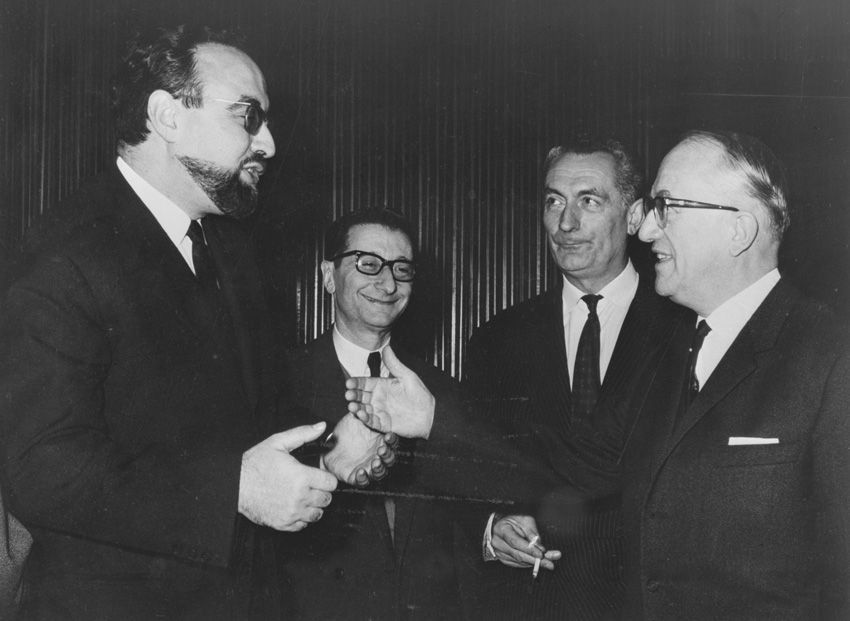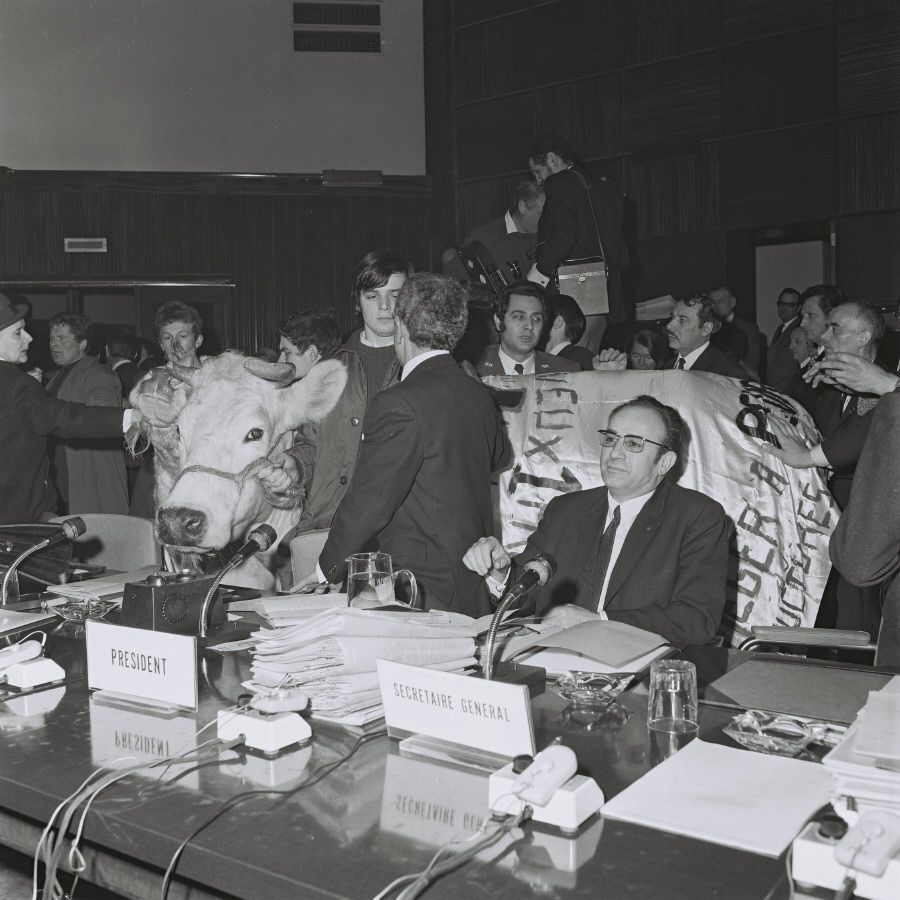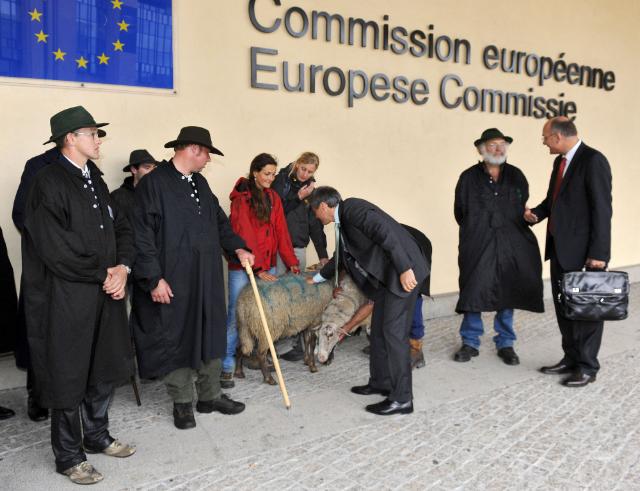Yesterday, I went to a talk by a rep of Germanwatch, a German NGO, on European Agricultural Policy and its relationship to climate change. As part of the presentation, the presenter gave a great overview of how European agricultural policy evolved and I thought I’d reproduce it here for all the non-Europeans (and Europeans!) who don’t know where to start with this crazy continent. Obviously, it’s gonna be by no means complete or exhaustive.
Even before World War II, the countries of Europe had traditionally been net importers of food. Shipments of food were especially vital in the post-war years, and this may have been when the idea of food self-sufficiency took off. In the 1950s, the six founding members of the European Union (Germany, France, Italy, Netherlands, Belgium, and Luxemburg) – still called the European Economic Community – created a common market, and in 1962 started its ‘common agricultural policy’. The political aim of this was to help the crippled agricultural sector of post-war Europe to produce more and to guarantee farmers an adequate standard of living.

© European Union, 2013
This was achieved by setting guaranteed minimum prices, and establishing a protection of the common market against imports. When world market prices dropped below the price guarantees, the EU would use market interventions to buy up the excess commodities – basically, any farmer could go to his respective state and request to sell his wheat, milk, or beef at the guaranteed price level. The governments then had to deal with these huge stocks of products, often selling them at a loss in the world market again. Later on, the governments would try to skip this middle step and just allocate export subsidies to farmers that would bridge the gap between the (higher) European prices and world market prices, so that farmers would still be well off in Europe.
These policies worked extremely well, and the EU developed into a major leading exporter in milk, beef and wheat (as well as other products). However, in the 1970s and 1980s policy-makers realized that they had maybe been a little too efficient. The price guarantee had completely suppressed the market regulation mechanism: normally, an excessive supply relative to demand would push prices down, and that on the flipside would decrease supply until it meets demand again. Since there was a price floor imposed by the EU, this step never happened. At the highest level, in 1991, the EU was spending 21 billion Euros on market interventions – buying up excess goods – and another 10 billion on export subsidies. This lead to consistent overproduction, and the EU was stockpiling the commodities it had committed to buying – there was talk of butter mountains and lakes of milk that they had to be storing somewhere. At the same time, developing countries were often the destination of choice for European cheap exports, causing them to accuse the EU of dumping foods under the production value onto their markets and destroying their agricultural sectors in the wake. Something had to change.

© European Union, 2013
Starting in the 1980s, quotas were imposed on milk and sugar production to get overproduction under control. Then, in 1992, a major reform converted the price support mechanism into a more ‘decoupled’ (meaning affecting production to a lesser degree) area payment scheme. To compensate for rather drastic drops in the minimum guaranteed prices (cereal guaranteed prices dropped by 35%, and beef prices by 15%), farmers were paid per hectare of a particular commodity they produced (say, per hectare of wheat or corn) or per head of cattle they raised. The idea was to support farm incomes without distorting world markets so much and giving wrong production incentives. In consequence, the wheat and beef exports dropped slightly, but on the other hand the lower price of cereals (which are also used for feed) led to an increase in pork export, and milk export still expanded as well.
In the Agenda 2000 reform, it was agreed that an additional goal of EU agricultural policy should be to promote the vitality of rural areas and to respect environmental concerns when giving agricultural support. Thus, the so-called Pillar II was born, which co-finances rural development and agri-environmental projects. Co-financing means that the EU chips in 50 – 80% of project costs, while Member States are responsible for the rest.
Finally, in 2003 the last big change was introduced, where area payments were even further decoupled. Now, a farmer gets paid for each hectare that he or she keeps in agricultural production, and it is no longer important which crops they grow. The payments were originally based on historical precedent, which led to the fact that they are still rather disparate. As an example, German farmers can expect to receive 330 – 340 Euros per hectare of agricultural land they own, as long as they keep the area in good environmental and agricultural conditions. Additionally, certain per-head payments for animals were still allowed at the discretion of Member States in order to prevent the abandonment of production. To become eligible for area payments, farmers have to comply with certain basic environmental, animal welfare, public and plant health regulations – the so-called cross-compliance. However, NGOs have criticized that these rules are much too lax; according to a German newspaper, it is “as if a car driver got a subsidy for stopping at a red light.”

The next Common Agricultural Policy is currently being discussed and should be agreed upon this summer, to cover the years 2014 to 2020. Big focus areas are a more just distribution of area payment amounts between and across regions; a stronger focus on additional environmental cross-compliance (the so-called “Greening” of the CAP); and to increase innovation and competitiveness of the agricultural sector through a strengthening of rural areas.
Today, the Mediterranean and the ACP (Africa, Caribbean, Pacific) regions are still some of the largest markets for EU dairy exports, continuing the history of exporting to low-income countries. In addition, the last years have seen a massive liberalisation of feed imports (feed now accounts for 67% of EU agricultural imports, and soy meal alone accounts for 35%) in order to support the rather intensive animal production on the continent. According to a German agricultural economist at the Humboldt University, this import in soy and cereal products is equivalent to the import of 20 Mio ha of production surface – and this production surface has most commonly been transformed from rain forest or savannahs in Latin America. Thus, according to Germanwatch, Germany alone imports the equivalent of 17 Mio tonnes of CO2, an additional quarter of the greenhouse gas emissions its agricultural sector produces, in the form of soy meal.
Sadly, the conclusion at our talk was that the policy reform of 2014 will not be powerful enough to overturn the direction our system is headed now. The “Greening” suggestions were only tentative and watered down quite much during the Parliamentary hearings. According to our presenter, the most important change – both environmentally and with regard to market distortions – would be to decrease the production (and consumption) of animal products, but it seems that there is rather a movement toward the stronger reintroduction of per head payments, which gives incentives in directly the other direction… I will keep you updated!
Bonus: If you have hours to lose, the EU actually has a pretty good website with all key documents and short summaries of the CAP developments here. There is also a nice virtual exhibition on 50 years of the CAP here (though of course it’s a very uncritical picture of it.)
Excellent summary, Janina.
Reblogged this on Say No To Food Waste and commented:
Thank you Food (Policy) For Thought!! I think it is a very important post to any European (and not only) that is interested in Food related issues. A very good read!
Thanks for reblogging it!
Thanks for writing it:P